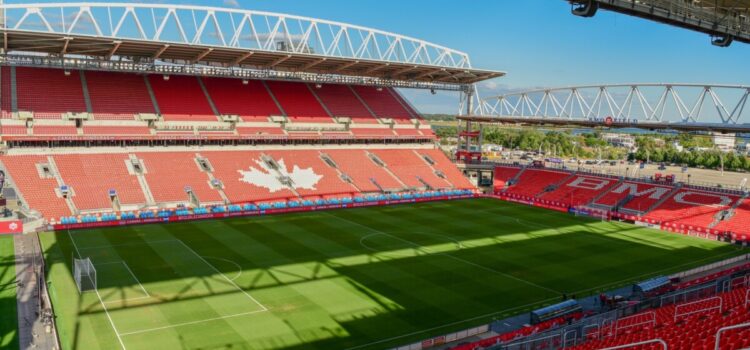

“We’re hosting as a legitimate soccer country”: 2026 World Cup preparation crucial to Canadian soccer
CanadaNewsSportsToronto Dec 8, 2021 Benedict Rhodes

FIFA officials were in Canada over the past few weeks to check out two potential host cities for the Canadian matches during the 2026 World Cup, Toronto and Edmonton.
The 2026 tournament will be hosted across three countries: Canada, Mexico and the United States, with Canada expected to host 10 matches.
The FIFA officials attended a World Cup Qualifying match against Mexico in Edmonton — an already-famous victory for Canada in front of nearly 50,000 fans — before heading east to Toronto.
One of the things many people have their eye on in the lead-up to the 2026 World Cup is the legacy it will have on youth soccer, and inspiring the next generation of soccer players, coaches, referees, etc.
“It’s not something that I ever truly imagined could be a reality growing up, to be honest,” said Ryan Lindsay, Club Coordinator and Academy Coach at Bonivital Soccer Club in Winnipeg, MB. “The men’s World Cup always felt so foreign as a Canadian born in the early ‘90s. Always just too distant in the past and beyond reach in the present.
“Hosting the Women’s World Cup always felt more achievable just because of the prominence and success of our women’s team, they had earned it, and it was a dream to witness. The U-20 World Cup we hosted in ‘07 felt a little in the shadow of the arrival of MLS in Toronto and as an event to grease the wheels for further expansion into Canada.”
With the upwards trajectory that Canadian soccer is on at the moment, Lindsay thinks that the World Cup is coming at the perfect moment.
“This time, we’re hosting as a legitimate soccer country and Canadians can get behind their own team,” he added. “Our Women have won Olympic gold, our men are developing into a real force — the timing couldn’t be better, and I couldn’t be more excited about it.”
Lindsay also believes that the impact of a World Cup will be felt at the youth level across the country, including at his club Bonivital.
“If you look at the boom of interest hosting created in the States after USA ‘94, Canada is in a much better position to capitalize on the new interest and enthusiasm that hosting a World Cup brings to a country than the USA was at that point. MLS was born out of the post-’94 World Cup interest and had to rekindle what had been left by the NASL – we already have an established and steadily growing and developing soccer infrastructure in place.
“From youth clubs up to leagues like League One Ontario, Première Ligue de soccer du Québec, and League One BC, to our USL franchises, up to the CPL and MLS, there are rapidly growing institutions for players to develop and eventually populate our own domestic leagues and teams.
“We have the landscape set for kids to be able to dream about being a star at home, and that will not only create new players for youth clubs, but keep kids in the game to play amateur, professionally, to become coaches, and remain fans for life.”
There are questions being asked, however, about whether or not Toronto and Edmonton are ready to host a World Cup.
From a pure soccer perspective, they likely are. BMO Field and Commonwealth Stadium are two of the leading stadiums in the country, and have proven on countless occasions, including the recent World Cup Qualifiers with massive crowds, that they can host such events.
Both will need some modernization, with Commonwealth needing to be converted to a natural grass pitch, and BMO needing to expand the stadium capacity.
“We saw what the Grey Cup bleachers on the north and south end (of the stadium) looked like in two different years for Grey Cup and MLS Cup and the MLS playoffs,” said Jeffrey Nesker, writer for Toronto FC blog Waking The Red, about how they might go about expanding BMO Field. “It wasn’t very elegant, and I think that anybody who sat on them for longer than 45 minutes would curse their very construction, but that’s probably what we’ll end up seeing because that’s the path of least resistance.”
Away from the pitch, other things will need to be improved, and likely built. One specific example is a bridge linking the Liberty Village neighbourhood of Toronto with the area surrounding BMO Field, over the train tracks.
Presently, there’s a tunnel that gets log-jammed every single time there’s an event at the venue — sometimes dangerously so. It’s an issue that would only be amplified with stadium expansion and larger crowds.
“I don’t know if any city is ready to host an event as big as the World Cup, I think it’s always a shock to the system,” Nesker added. “The tunnel to get to Liberty Village is a disaster, and that’s with just regular fans. If you multiply that, it’s going to be rough.
“Parking I think is going to be okay, with the advantage of all the parking lots around there…you can definitely handle the influx of cars. Nobody’s going to have a fun time driving around there at a snail’s pace, but they’re all going to fit. The pedestrian traffic is going to be difficult.”
Whatever happens, one thing is certain: World Cup games are coming to Canada and it’s going to be massive. Preparation will be crucial. Not only for the event itself, but for the legacy it will leave behind.






